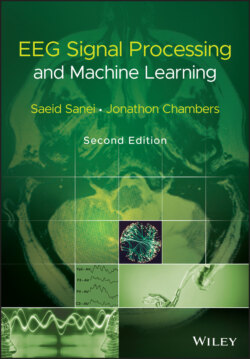Читать книгу EEG Signal Processing and Machine Learning - Saeid Sanei - Страница 63
4.2 Nonlinearity of the Medium
ОглавлениеThe head as a mixing medium combines EEG signals which are locally generated within the brain at the sensor positions. As a system, the head may be more or less susceptible to such sources in different situations. Generally, an EEG signal can be considered as the output of a nonlinear system, which may be characterized deterministically. This concept represents the fundamental difference between EEG and magnetoencephalography (MEG) signals. Unlike in EEG, for MEG the resistivity (or conductivity) of the head has significantly less effect on the magnetic field although the slight nonlinearity in MEG stems from minor differences in head tissue permittivity values.
Electromagnetic source characterization and localization requires accurate volume conductor models representing head geometry and the electrical conductivity field. It has been shown that, despite extensive research, the measurements of head tissue parameters are inconsistent and vary in different experiments [10]. There is more discussion on this concept in Chapter 10 of this book where we introduce brain source localization.
The changes in brain metabolism as a result of biological and physiological phenomena in the human body can change the process of combining the EEG source signals. Some of these changes are influenced by the activity of the brain itself. These effects make the system nonlinear. Analysis of such a system is very complicated and up to now nobody has fully modelled the system to aid in the analysis of brain signals.
Conversely, some measures borrowed from chaos theory and analysis of the dynamics of time series such as dissimilarity, attractor dimension, and largest Lyapunov exponents (LLE) can characterize the nonlinear behaviour of EEG signals. These concepts are discussed in Section 4.7 and some of their applications given in Chapter 11.
